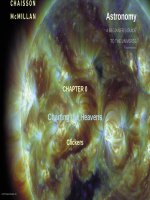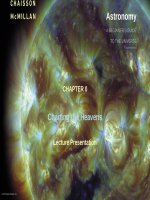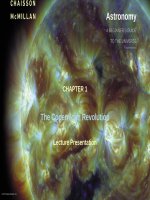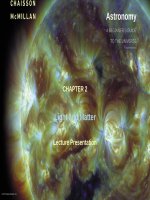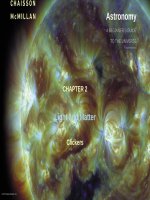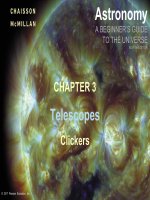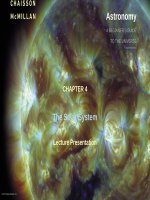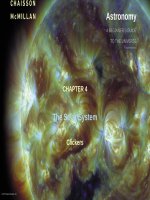Astronomy a beginners guide to the universe 8th CHaisson mcmillan chapter 0
Bạn đang xem bản rút gọn của tài liệu. Xem và tải ngay bản đầy đủ của tài liệu tại đây (2.28 MB, 25 trang )
Astronomy
A BEGINNER’S GUIDE
TO THE UNIVERSE
EIGHTH EDITION
CHAPTER 0
Charting the Heavens
Lecture Presentation
© 2017 Pearson Education, Inc.
Chapter 0 Charting the Heavens
© 2017 Pearson Education, Inc.
Units of Chapter 0
•
•
•
•
•
•
The “Obvious” View
Earth’s Orbital Motion
The Motion of the Moon
The Measurement of Distance
Science and the Scientific Method
Summary of Chapter 0
© 2017 Pearson Education, Inc.
0.1 The “Obvious” View
•
Earth is average—we
don’t occupy any special
place in the universe
•
Universe: Totality of all
space, time, matter, and
energy
•
Astronomy: Study of the
universe
•
Scales are very large,
measured in light-years,
the distance light travels
in a year—about 10 trillion miles
© 2017 Pearson Education, Inc.
0.1 The “Obvious” View
•
Stars that appear close in the sky may not actually be close in space.
© 2017 Pearson Education, Inc.
0.1 The “Obvious” View
•
The celestial sphere:
–
Stars seem to be on the inner surface of
a sphere surrounding the Earth.
–
They aren’t, but we can use twodimensional spherical coordinates
(similar to latitude and longitude) to
locate sky objects.
© 2017 Pearson Education, Inc.
More Precisely 0.1: Angular Measure
•
•
•
Full circle contains 360º (degrees).
Each degree contains 60′ (arc minutes).
Each arc minute contains 60″ (arc
seconds).
•
Angular size of an object depends on its
actual size and distance away from Earth.
© 2017 Pearson Education, Inc.
0.1 The “Obvious” View
•
•
Declination: Degrees north or south of celestial equator
Right ascension: Measured in hours, minutes, and seconds eastward from position of the
Sun at vernal equinox
© 2017 Pearson Education, Inc.
0.2 Earth’s Orbital Motion
•
Daily cycle, noon to noon, is diurnal
motion—solar day.
•
Stars aren’t in quite the same place 24
hours later, though, due to Earth’s rotation
around the Sun; when they are in the
same place again, one sidereal day has
passed.
© 2017 Pearson Education, Inc.
0.2 Earth’s Orbital Motion
•
The 12 constellations the Sun moves through during the year are called the zodiac; its
path is ecliptic.
© 2017 Pearson Education, Inc.
0.2 Earth’s Orbital Motion
•
Ecliptic is plane of Earth’s
path around the Sun, at
23.5º to celestial equator.
•
Northernmost point
(above celestial equator)
is summer solstice;
southernmost is winter
solstice; points where
path crosses celestial equator are vernal and autumnal quinoxes.
•
•
Combination of day length and sunlight angle gives seasons.
Time from one vernal equinox to next is tropical year.
© 2017 Pearson Education, Inc.
0.2 Earth’s Orbital Motion
•
Precession: Rotation of Earth’s axis itself; it makes one complete circle in about 26,000
years.
© 2017 Pearson Education, Inc.
0.2 Earth’s Orbital Motion
•
•
Time for Earth to orbit once around the Sun, relative to fixed stars, is a sidereal year.
Tropical year follows seasons; sidereal year follows constellations. In 13,000 years, July
and August will still be summer, but Orion will be a summer constellation.
© 2017 Pearson Education, Inc.
0.3 The Motion of the Moon
•
The Moon takes about 29.5 days to go
through
whole cycle of phases—the synodic
month.
•
Phases are due to different amounts of
sunlit portion
being visible from Earth.
•
Time to make full 360º around Earth,
sidereal month, is about 2 days shorter
than synodic month.
© 2017 Pearson Education, Inc.
0.3 The Motion of the Moon
•
Lunar eclipse:
–
–
–
Earth is between the Moon and Sun.
A partial eclipse occurs when only part of the Moon is in shadow.
A total eclipse occurs when all is in shadow.
© 2017 Pearson Education, Inc.
0.3 The Motion of the Moon
•
Solar eclipse: The Moon is between Earth and Sun.
© 2017 Pearson Education, Inc.
0.3 The Motion of the Moon
•
A solar eclipse is partial when only part of the Sun is blocked, total when all is blocked,
and annular when the Moon is too far from Earth for total.
© 2017 Pearson Education, Inc.
0.3 The Motion of the Moon
•
Eclipses don’t occur every month because Earth’s and the Moon’s orbits are not in the
same plane.
© 2017 Pearson Education, Inc.
0.3 The Motion of the Moon
•
Eclipse tracks, 2010–2030
© 2017 Pearson Education, Inc.
0.4 The Measurement of Distance
•
Triangulation: Measure baseline and angles, and you can calculate distance.
© 2017 Pearson Education, Inc.
0.4 The Measurement of Distance
•
Parallax: Similar to triangulation, but looking
at apparent motion of object against distant
background from two vantage points
© 2017 Pearson Education, Inc.
0.5 Science and the Scientific Method
•
Scientific theories:
–
–
–
–
•
Must be testable
Must be continually tested
Should be simple
Should be elegant
Scientific theories can be proven wrong, but they can never be proven right with 100%
certainty.
© 2017 Pearson Education, Inc.
0.5 Science and the Scientific Method
•
•
•
Observation leads to a theory explaining it.
Theory leads to predictions consistent with previous observations.
Predictions of new
phenomena are
observed. If the
observations agree
with the prediction,
more predictions can
be made. If not, a new
theory can be made.
© 2017 Pearson Education, Inc.
Summary of Chapter 0
•
•
•
•
•
•
Astronomy: Study of the universe
Stars can be imagined to be on inside of celestial sphere; useful for describing location.
Plane of Earth’s orbit around Sun is ecliptic, at 23.5º to celestial equator.
Angle of Earth’s axis causes seasons.
Moon shines by reflected light, has phases.
Solar day ≠ sidereal day, due to Earth’s rotation around Sun.
© 2017 Pearson Education, Inc.
Summary of Chapter 0, cont.
•
•
•
•
Synodic month ≠ sidereal month, also due to Earth’s rotation around Sun.
Tropical year ≠ sidereal year, due to precession of Earth’s axis.
Distances can be measured through triangulation and parallax.
Eclipses of Sun and Moon occur due to alignment; only occur occasionally as orbits are
not in same plane.
•
Scientific method: Observation, theory, prediction, observation…
© 2017 Pearson Education, Inc.
